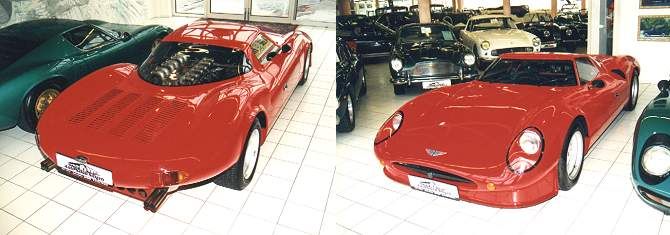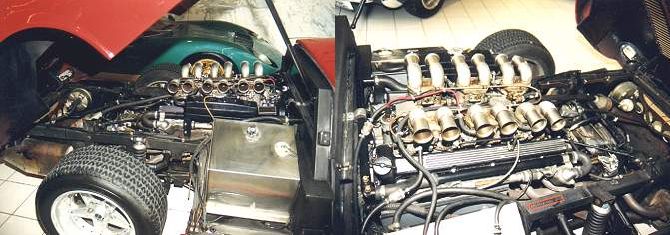Description
The Invicta XJ 13 was an extraordinary and mysterious creation — a bold, one-off prototype that fused the engineering brilliance of the 1960s with the spirit of a legendary British marque. Inspired by the sleek Jaguar XJ13 racing car, the Invicta XJ 13 represented an attempt to rekindle the Invicta name in the late 1960s by building a modern grand tourer with the beauty of a Le Mans racer and the comfort of a luxury coupé. Although only a single prototype is known to have been built, the Invicta XJ 13 remains one of the most striking and enigmatic British concept cars of its era — a dream in aluminium that captured the imagination of enthusiasts even if it never reached production.
The Invicta name had lain dormant since the early 1950s, when production of the technically advanced but prohibitively expensive Black Prince came to an end. By the mid-1960s, interest in reviving great pre-war British marques was growing, as small companies sought to blend heritage with modern performance. It was in this context that a project emerged to create a new Invicta — one that would recapture the brand’s reputation for speed and engineering excellence, but reinterpret it for a new age of aerodynamics, alloy construction, and mid-engine layouts. The car that resulted was the Invicta XJ 13, a project whose very name paid homage to one of the most beautiful racing cars ever built: the Jaguar XJ13.
Externally, the Invicta XJ 13 was clearly inspired by the Jaguar, yet it was not a direct copy. The design, hand-formed in aluminium by British craftsmen, combined the flowing lines of a 1960s endurance racer with the elegance of a road-going grand tourer. The body featured a low, sculpted nose with covered headlamps, dramatic air intakes along the flanks, and a sweeping canopy-style cockpit with wraparound glass. The proportions were pure performance: a long tail, wide haunches, and a stance that seemed poised for motion even at rest. The craftsmanship of the prototype was impressive — a blend of racing minimalism and coachbuilt artistry that evoked both the Jaguar’s aerodynamic grace and Invicta’s tradition of refined engineering.
Beneath the bodywork, the Invicta XJ 13 was constructed on a lightweight tubular spaceframe chassis, designed to provide both rigidity and balance for high-speed handling. The car’s mid-engine layout placed its powerplant behind the seats and ahead of the rear axle, ensuring near-perfect weight distribution. While early reports suggested that the car might use a Jaguar-sourced engine, other accounts claim that the prototype was fitted with an American V8, possibly a 5.0-litre Ford or Chevrolet unit, tuned for smoothness and torque rather than outright racing power. In either form, the output was estimated at around 300 horsepower — enough to propel the car beyond 150 mph, making it one of the fastest British road cars of its time.
Suspension followed contemporary racing practice, with independent double wishbones and coil-over dampers at all four corners, while braking was handled by four large discs — advanced technology for a hand-built British GT of the late 1960s. Steering was rack-and-pinion, and the transmission, depending on configuration, could be either a manual ZF five-speed unit or a Borg-Warner automatic, reflecting Invicta’s intent to combine supercar performance with the civility of a touring car.
The interior of the Invicta XJ 13 prototype was striking in its blend of competition minimalism and gentlemanly luxury. Two deeply contoured seats were trimmed in fine leather, separated by a narrow transmission tunnel. The dashboard carried a set of Smiths instruments — tachometer, oil pressure, fuel, and temperature gauges — set within a brushed aluminium panel. Switchgear was aircraft-like in precision, and the three-spoke wood-rimmed steering wheel was a nod to traditional British craftsmanship. Though the car’s cockpit was compact, it was surprisingly well appointed, with carpeting, a heater, and acoustic insulation — details that hinted at Invicta’s intention to market the car not as a racer, but as a refined, road-going sports coupé in the mould of the Iso Grifo or AC 428.
The Invicta XJ 13 project, however, was doomed from the start by its timing and cost. The late 1960s were not kind to small British car manufacturers: materials were expensive, regulations were tightening, and new safety and emissions standards made bespoke production nearly impossible. Furthermore, the similarity to Jaguar’s own XJ13 — which remained an unreleased factory prototype — complicated marketing and legal prospects. Although the Invicta was conceived as a distinct design, Jaguar’s close association with the XJ13 name made any commercial release unviable. The car that had been intended as a symbol of Invicta’s rebirth became instead a fascinating one-off, admired but never fully realized.
Nonetheless, the Invicta XJ 13 was an extraordinary car in both vision and execution. It represented the same values that had defined the marque in the interwar years — craftsmanship, mechanical excellence, and a commitment to speed — but reimagined through the lens of 1960s technology. It was a car that stood between eras: the hand-built artistry of the past meeting the aerodynamic science of the modern age.
Today, the lone Invicta XJ 13 prototype survives as one of the most intriguing curiosities in British motoring history. Its blend of elegance, power, and rarity makes it a highly regarded piece among collectors and historians, even if its details remain somewhat shrouded in mystery. It captures the enduring appeal of the Invicta name — a marque that, across decades, remained synonymous with individuality, innovation, and craftsmanship.
The Invicta XJ 13 was never a production car, nor a racing machine, but rather a dream made real — a glimpse of what Invicta might have become had history and circumstance allowed. It stands as a fitting epilogue to one of Britain’s most noble motoring traditions: a car of beauty, strength, and unconquered ambition.



